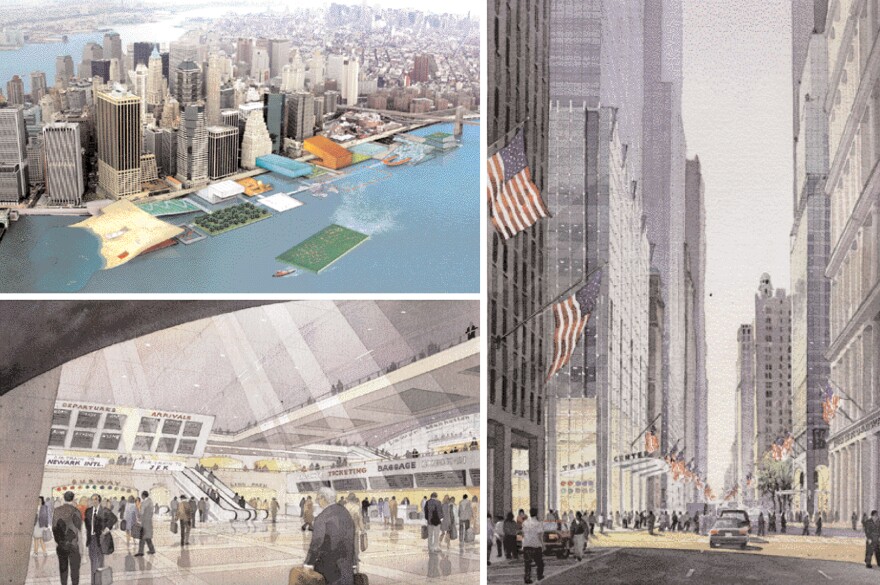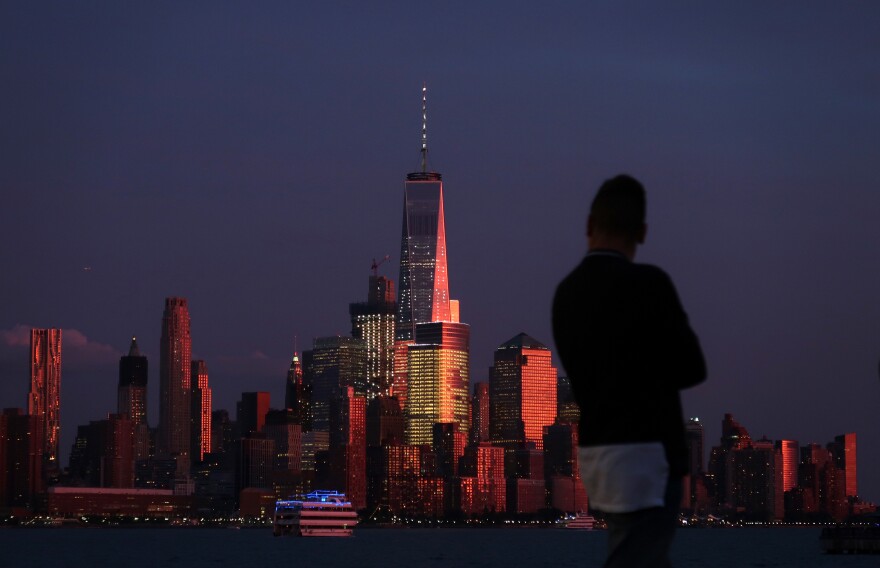When a man-made disaster of unfathomable scope strikes your city and its central symbol of prosperity has been leveled to ruin — and it's your job to jolt it into resurgence — where do you begin?
Only hours had passed after the planes struck New York City's twin towers on Sept. 11, 2001, when then-Mayor Rudy Giuliani made a promise to rebuild: "We're not only going to rebuild, we're going to come out of this stronger than we were before."
Four months later, New York's new mayor, Michael Bloomberg, stood on the flag-clad steps of City Hall and echoed that promise: "We will rebuild, renew and remain the capital of the free world. ... In the next four years I will devote myself to building a better New York."
Days later, Bloomberg's deputy mayor for economic development and rebuilding, Dan Doctoroff, assembled the heads of the city's many agencies in one room. He made a big request: Each team was to produce a strategic plan and a timeline for the next year. Regular updates would be presented at what would become monthly meetings.
People were dumbfounded, Doctoroff says. Part of it was the how: "No one had ever done PowerPoint before," he says. But also the what: "There was never that kind of level of City Hall-driven coordination on such a large scale." It's been decades since New York City had a citywide comprehensive planning vision.

What ensued was an exceptional flurry of urban strategizing, a city planning renaissance that produced some of New York's now-famous locations, some purely aspirational visions and a downtown better than before. All of this was fueled by deadlines imposed by a bid to host the Olympics, the money suddenly devoted to rebuilding and the nation's unified will to witness a rebirth.
It was the atmosphere of, "We've got to think big; we've got to do big things again," says Karen Phillips, who had spent years in real estate and community development before joining the city planning commission in 2002.
"Moral imperative to rebuild"
The plan didn't exactly begin at ground zero.
As far back as 1996, Doctoroff — then a private equity investor — had pitched an idea for how to recharge New York: host the Olympics. And in 2002, he brought the Olympic bid to City Hall.

Doctoroff's proposal envisioned new sports venues dotted throughout the entire city, an Olympic Village in Queens and the development of ferry transportation.
The idea was to site venues in communities that people had long talked about revitalizing "but had never been able to muster the political will or economic resources," Doctoroff says. And then use the Olympic process deadlines "to create a catalyst to getting things done."
Bloomberg's city planning chief, Amanda Burden, came in with a passion of her own, for turning industrial and underused areas into public spaces. And one particular love — the High Line.
"It was just the most beautiful thing I ever saw," she says. Burden and a few other devotees had been fighting to preserve what at the time was a disused and dilapidated railroad and turn it into an elevated park. It was slated for demolition after complaints from businesses below. "I kept thinking," Burden says, "if I didn't think about it every day, it would come down."
In fact, many of the ideas that materialized or were proposed after Sept. 11 had been simmering for a while. What changed was the impetus.
"We had almost a moral imperative to rebuild," Doctoroff says, "which enabled us ... to do things that people had talked about for a long time."
Beyond ground zero
By accounts of several city development veterans, Bloomberg's became the first extensive citywide vision since the late-1960s efforts of Mayor John Lindsay.
Eventually — after the Olympic bid was rejected — its many elements shaped a wide-ranging five-borough plan. But the bid became a kickstarter. That first year, Doctoroff says, the city began moving on half a dozen projects at once, in Manhattan, Brooklyn and Queens.

The centerpiece was Hudson Yards, a massive redevelopment of what was known as the "far West Side." Originally intended to house an Olympic stadium — a plan that was later voted down — the area is now a rising skyscraper cluster of apartments, offices and shops.
As a byproduct of Hudson Yards, the city also pushed to extend the subway 7 line to the area — a train that seemed at the time to go to "never-never land," as Phillips put it — the first new subway station in decades. The authorities also began to expand the ferry service and comb the city with rezonings and updated housing plans.
As Burden describes it, one of the plan's goals was to diffuse the spotlight from Manhattan to the other four boroughs: Brooklyn, Queens, the Bronx and Staten Island.
"This is a city — an archipelago, right?" she says. "The natural segue was: What connects all of our boroughs? Our waterfront."
And so, the city's attention also spread to New York's waterfronts, particularly those along both sides of the East River, in Brooklyn and Manhattan. Many riverfronts were long dotted with abandoned industrial sites.

"The goal of our waterfront plan ... was to have the water be part of New Yorkers' everyday lives," Burden says. "And it kind of is now, but that was the furthest thing from people's minds."
Aspirational Lower Manhattan
Yet one thing remained outside Bloomberg's plans: ground zero itself, where after the incredibly speedy cleanup, plans were underway for the construction of the memorial and new World Trade Center buildings.
There, in fact, the city was locked out of big decision-making, says Lynne Sagalyn, the author of Power at Ground Zero: Politics, Money, and the Remaking of Lower Manhattan.

The 16 acres of the World Trade Center site actually belong to the Port Authority, which is run by the states of New York and New Jersey. And then-New York Gov. George Pataki had a heavy influence on the city-state corporation formed to coordinate the rebuilding of the area, Sagalyn says.
What the city did have control over was some of the surrounding streets, she says. That gave the administration the opening to both leave its mark and take advantage of the financial windfall for the rebuilding of Lower Manhattan. The focus went to streets, parks and public spaces.
Very quickly, by December 2002, Bloomberg's office produced a "Vision for Lower Manhattan" — the financial district "envisioned as an urban hamlet," as The New York Times described it.

The area's problems were well-known. The World Trade Center had been cut off from the city; major streets didn't connect end-to-end. Banks and businesses had started relocating north to Midtown; it wasn't a prime place to live. "In the city that never sleeps," the mayor's proposal observed, "much of Lower Manhattan goes to bed promptly at 6 o'clock."
The city's plan to re-insert some of the downtown streets back into the grid — where the World Trade Center superblock had previously cut them off — was "the one true point of consensus" in the entire rebuilding of Lower Manhattan, says Sagalyn, a professor at Columbia Business School.
Burden says a lot of attention also went to knitting the sidewalks, the ramps and the landscaping together with the memorial and the World Trade Center. The waterfronts got a major makeover, too.

The mayor's plan also had envisioned an expanded transportation hub for the downtown area, including a direct train to John F. Kennedy airport (an element that proved too expensive to complete).
Doctoroff invited architects to re-imagine Lower Manhattan's public spaces, purely for inspiration. They dreamed up tree-lined roadways, a waterfront colonnade — even a sea-level ice skating rink and a downtown beach.

Doctoroff would call Lower Manhattan "an aspirational place," Burden says.
"The pile was still smoldering," she says. "It was important for people to think that there was a future for Lower Manhattan, and it was bright."
"Command our future"
How much of this work would have happened, had the Sept. 11 attacks not shattered New York City?
Doctoroff has a stark view: "Virtually none of it," he says — because Bloomberg wouldn't have been elected.
Bloomberg ran as a Republican, with Giuliani's endorsement, in a city that was 5-to-1 Democratic, clinching the victory just two months after the disaster — by only about 30,000 votes.
Doctoroff says he had "spent a lot of time talking" with Bloomberg's Democratic opponent, Mark Green, who was "dramatically less enthusiastic" about the city planning agenda.

Phillips says the eyes of the world being on New York City helped smooth the way for many proposals that would have otherwise been contentious.
"This started as New York's darkest day," Burden says. "There was a real doubt about whether the city would ever recover."
But she lists the many Bloomberg plans: the vision for Lower Manhattan, revitalization of all five boroughs, "reclaiming" of the waterfronts, creation of "inspirational" public spaces and pursuit of the Olympic bid.
"All of these had the same trajectory," Burden says, "that we're a global city, we're moving forward, we're a growing city, we're an optimistic city, we want to command our future."
Copyright 2023 NPR. To see more, visit https://www.npr.org.




